SMS marketing has made a comeback.
Though marketers have forgotten about SMS as a channel since smartphones appeared, high SMS open rates have made everyone interested again. SMS open rates average around 98%, so the ROI from SMS campaigns is naturally high.
In this article, let’s explore some exciting statistics about SMS open rates, SMS marketing, and engagement rates. By the time you end up reading these numbers, you’ll realize how profitable running an SMS marketing campaign for your business is. So, let’s get started.
What is SMS Open Rate?
SMS open rate is the percentage of recipients who open and read an SMS message out of the total number of recipients in an SMS campaign. For example, if you send an SMS to 100 prospects and 90 out of them open it, your open rate for SMS is 90%.
SMS open rate is an important metric for gauging the efficacy of an SMS marketing campaign. Compared to other forms of digital communication, like emails, SMS boasts staggeringly high open rates.
Why? Well, think about your relationship with your phone. An SMS is immediate, often alerting the user instantly. It’s personal, landing straight into the same inbox where messages from friends and family appear.
Plus, it doesn’t require an internet connection, making it accessible to even more people.
Want to start SMS marketing? Try Sender — it’s effortless, affordable and effective.
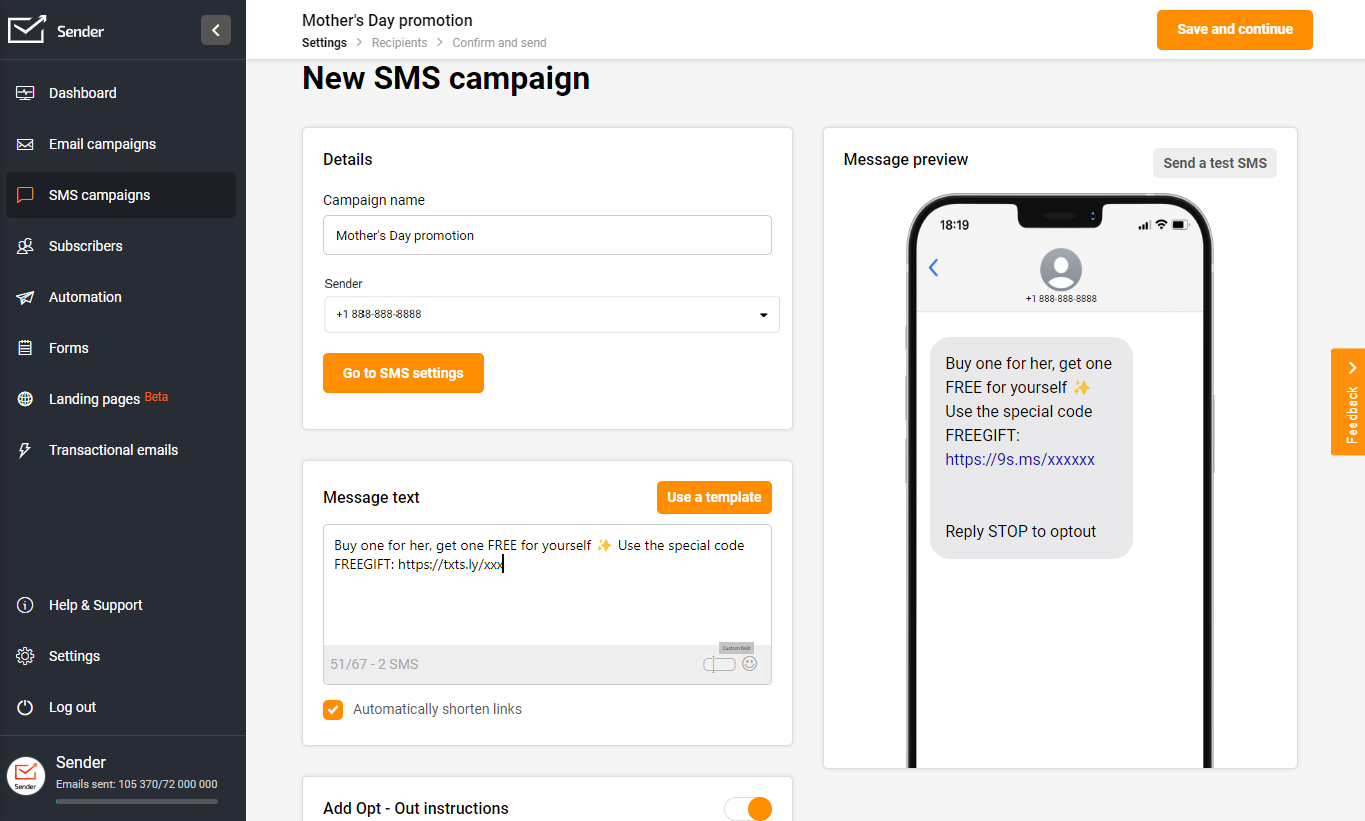
What are Standard SMS Marketing Open Rates?
If you trust actual data before experimenting with any marketing channel, you’d love the following statistics about SMS open rates.
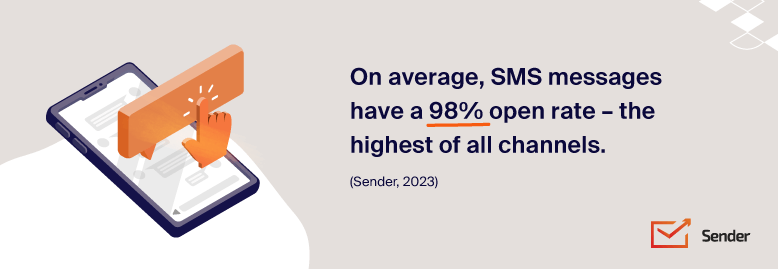
According to research, on average, SMS messages have a 98%* open rate. Compared to email, this is almost five times more. Here are some more SMS marketing statistics:
- 90%* of people open a text within three minutes;
- 85% of smartphone users prefer SMS to emails or calls;
- 82% of consumers check their text notifications within five minutes—and nearly 32% do so within just 60 seconds*;
- One in three customers sends an SMS to a business but never receives a reply;
- 55% of customers ignore marketing emails but are open to other forms of marketing.
SMS isn’t a medium that should be ignored, not after you’ve come across these compelling SMS open rate statistics.
SMS Open Rates vs. Engagement Rates
The open rates for text messages are highly promising. But you should always look beyond open rates and study engagement rates of text marketing campaigns. But before we move on to the discussion, let’s understand the difference.
SMS open rate is a straightforward metric. It tells you how many recipients open and read the SMS message. It’s a preliminary benchmark that tells businesses and marketers whether their message is getting seen.
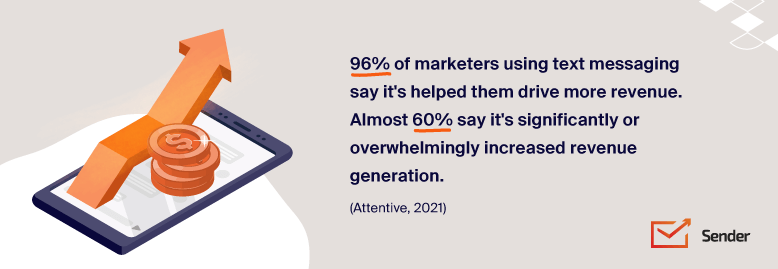
However, a high open rate doesn’t necessarily translate to action. It simply means the message was viewed. Additionally, some marketers say that open rates bring with them a certain negative. People check their phones often and unsubscribe more often when compared* to emails.
Thus, a better metric is engagement rate which measures customer engagement in a marketing campaign. It doesn’t just register the ‘viewing.’ Instead, it records if (and how) the recipient interacts with the SMS content.
This could involve clicking on a link in the message, replying to the SMS, or taking any defined action the sender desires the recipient to take. A higher engagement rate signifies not only visibility but the effective motivation of the recipients to act.
| SMS Open Rates | Engagement Rates | |
| Focus | Measures the percentage of recipients who open the SMS. | Measures the percentage of recipients interacting with the SMS content in some actionable way. |
| Depth of Interaction | Reflects passive consumption. Recipients just view the message. | Indicates active interaction. Records recipients who engage with the message, e.g., clicking a link or replying. |
| Impact | Shows the message’s visibility and initial reach. | Demonstrates the effectiveness and persuasive power of the message. |
| Dependency | Often higher since SMS is direct and personal. | It can vary greatly depending on the call-to-action and content quality. |
| Used For | Assessing initial interest and message penetration. | Evaluating the success of campaigns and understanding recipient behavior. |
Read vs. Open Rate
Just as there’s an evident difference between engagement and open rates, there’s a clear difference between open and read rates. This important distinction is essential due to SMS marketing campaigns registering the highest open rates.
SMS open rate indicates how many recipients have opened the text message on their device. It’s a preliminary metric indicating the first step of engagement — a signal that the message has grabbed the recipient’s attention, compelling them to open and glance at its content.
But here’s a caveat: just because an SMS has been opened doesn’t always mean it’s been comprehensively read.
The SMS read rate goes a step further than the open rate. It aims to quantify how many recipients haven’t only opened the SMS but also taken the time to read its content, whether in its entirety or significantly. Think of it as a bridge between the open and engagement rates.
Though harder to measure accurately, it provides a deeper insight into the effectiveness of the message. A high read rate indicates that the content within the message was engaging enough to retain the recipient’s attention beyond just a mere glance.
| SMS Open Rate | SMS Read Rate | |
| Focus | Measures the percentage of recipients who open the SMS. | Measures the percentage of recipients who read the content of the SMS. |
| Depth of Interaction | Indicates initial interest by simply opening the message. | Demonstrates a deeper level of engagement by consuming the content. |
| Impact | Highlights the message’s ability to grab attention initially. | This signifies the message’s ability to retain interest and engagement. |
| Dependency | Factors like sender identity and message preview can influence it. | Heavily reliant on the quality and relevance of the message content. |
| Used For | Evaluating the immediate impact and initial reach of the message. | Assessing the overall effectiveness and resonance of the message content. |
With these differences in mind, analyze your SMS marketing performance and experiment with your campaigns. Now, look at some actual SMS marketing and open rate statistics.
SMS Open Rates Statistics
Before we look at the open rates in depth, let’s quickly explore the potential of SMS marketing through some riveting statistics about SMS marketing.
- SMS open rates hover between 95-99%, with an average of about 98%;
- 91%* of customers worldwide have signed up for SMS marketing campaigns (or are keen on signing up);
- 63% of customers engage with SMS programs at least twice a week;
- Millennials are most likely to buy for the first time after subscribing to an SMS from a brand;
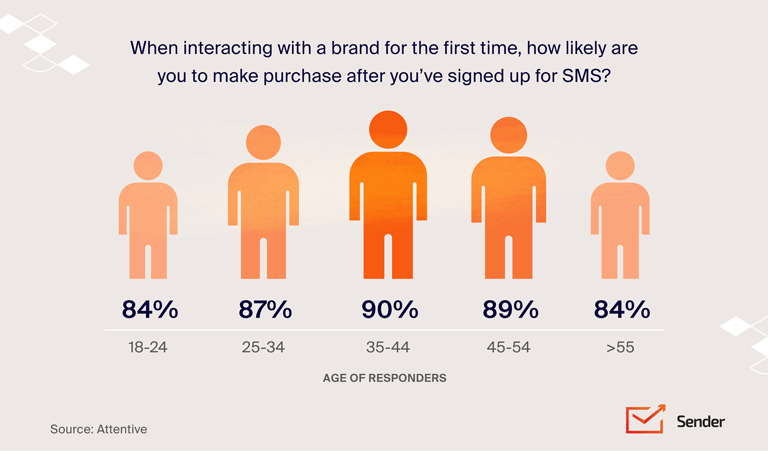
- 68% of consumers in the US have spent $50+ on buying an item through text messaging; 22% have splurged up to $500.
- 34% of people feel that 1 text message per week from businesses is enough;
- Consumers in the US who sign up for SMS campaigns are 87% more likely to make a purchase. In the UK, Australia, and Canada, the figures are 80%, 82%, and 78%, respectively;
- For marketers, SMS is one of the top three revenue-driving channels. In fact, for 22% of marketers, SMS drives over 20% of the total revenue for the brand;
- 64%* of customers feel curious when they receive a text from a brand, 27% feel happy, and 23% feel excited. 17% of people get anxious, and the other 15% feel annoyed when they receive a brand text on their mobile phone;
- Most customers prefer receiving text on weekdays between 9:00 am-5:00 pm;
- 30% of consumers are fine with receiving more than one text daily on their mobile phones from brands and businesses.
Now that you have seen the potential, let’s quickly explore the different statistics that will guide your SMS marketing strategy.
SMS Engagement Rates
SMS doesn’t just register high open rates. Personalized messages sent to the target audience also register a great CTR — 10.66%* on average. SMS campaigns are also known to increase the number of orders by 23.8%.
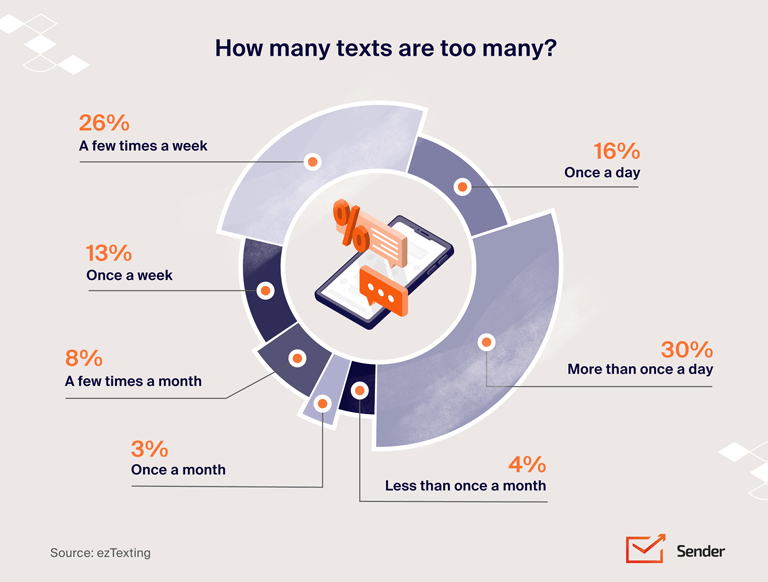
SMS Click-Through Rates
If you’re curious if SMS campaigns are for you, here’s the average CTR data* for different industries. This clickthrough data is recorded for a typical welcome message sent to subscribers who opted-in for SMS marketing.
- Apparel: 6.6% – 24.7%;
- Footwear: 8.5% – 31.7%;
- Health & Beauty: 5.8% – 27%;
- Home & office: 7.6% – 26.8%;
- Children & baby apparel: 4.1% – 19.9%;
- Petcare: 4.8% – 20.6%;
- Jewelry & accessories: 7% – 27%;
- Electronics: 6.9% – 30.5%;
- Sports & fitness: 8.9% – 28.3%;
- Food & beverage: 5.4% – 29.8%;
- Grocery: 6.9% – 35.8%;
- Restaurants: 5% – 30.4%;
The average CTR is much better than emails, which register an average clickthrough rate of 2.5%.
Time-Based Open Rates
SMS marketing receives phenomenal responses from consumers. But when should you send your SMS campaigns?
While there are no exact studies on the open rate by hour for SMS, we’ve curated the best times to send an SMS campaign for your brand in 2024. As per multiple sources, here are some of the insights:
The top three times to schedule SMS blasts are noon, 2:00 pm, and 6-8 pm. Here’s a table for priority if three slots appear too limiting:
- Thursday at 2:00 p.m.
- Friday at 12:00 noon
- Saturday between 7:00 – 8:00 p.m.
- Friday between 10:00 – 11:00 a.m.
- Thursday at 6:00 a.m.
- Saturday at noon
- Tuesday at 2:00 p.m.
- Tuesday at 6:30 p.m.
- Thursday between 1:00 – 2:00 p.m.
- Saturday at 10:00 a.m.
Factors Influencing SMS Open Rates
There are many things that affect how many people open your SMS. The most important factors out of these include:
- Timing and frequency of messages. Sending messages at the right time boosts open rates. Check your analytics to find the best time when your audience engages. Avoid spamming and send at an optimal frequency without annoying;
- Personalization and relevance of content. Tailored messages resonate more with prospects. Use personalized content and relevant offers to grab attention and encourage engagement;
- Sender reputation and trust. A trusted sender name and a clean sending history make you more credible. Plus, it builds a reputation with texting service providers, which improves deliverability and open rates.
Key Takeaways: SMS Open Rates
Adding SMS marketing to your marketing mix is a sound decision. It can cover several important aspects of the business – from a supportive role for emails to delivering time-sensitive messages.
In short, SMS can cover deliver great results regardless of the approach taken; just keep in mind the following:
- Use SMS campaigns along with other marketing strategies to get the maximum benefits;
- Always test SMS open rates with a smaller sample audience group to plan for future SMS marketing campaigns;
- Follow up using SMS messages for abandoned carts and other email marketing campaigns to increase open rates;
- Write concise and compelling SMS copy if you want to get the benefits of high open rates of SMS campaigns.
Interested in more mind-blowing SMS marketing features? Check out the articles below:
- What is the SMS Character Limit? (Max. Text Message Length)
- 13 Best SMS Marketing Platforms in 2025 | Software Compared
- Email and SMS Marketing: Getting Started with Perfect Duo
*Sources
- https://www.pcmag.com/news/businesses-take-note-your-customers-prefer-texts/
- https://info.sopranodesign.com/the-power-of-mobile-communications/
- https://on.emarketer.com/rs/867-SLG-901/images/eMarketer%20SMS%20Marketing%202021%20Report.pdf
- https://www.statista.com/topics/5983/mobile-marketing-worldwide/#topicOverview/
- https://www.attentive.com/2023-sms-marketing-benchmarks-report/
- https://www.eztexting.com/report/2022-state-of-texting-consumer-behavior-report/
- https://www.tatango.com/blog/average-sms-marketing-opt-in-rates/
- https://www.attentive.com/blog/best-time-to-send-sms-marketing/
- https://simpletexting.com/sms-marketing/campaigns/best-time-to-send/
- https://simpletexting.com/blog/2025-texting-and-sms-marketing-statistics/

